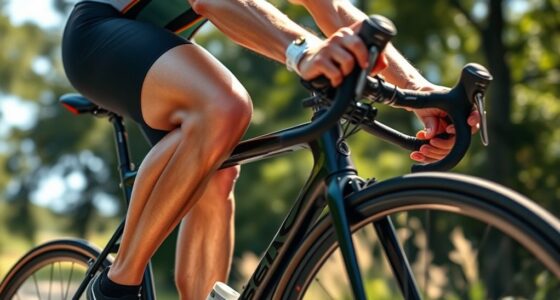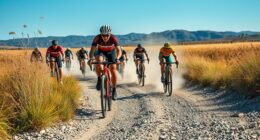To fuel your rides for peak performance, focus on consuming carbohydrates before and during your ride to boost energy and store glycogen. Incorporate protein within 30–60 minutes post-ride for muscle repair, and include healthy fats for sustained stamina. Stay hydrated by drinking fluids with electrolytes before, during, and after cycling. Adjust your nutrition timing and quality, and consider supplements if needed. Keep exploring to discover more tips that can elevate your cycling results.
Key Takeaways
- Prioritize carbohydrate intake before and during rides to maximize energy and glycogen stores for endurance.
- Consume high-quality protein within 30-60 minutes post-ride to support muscle repair and reduce soreness.
- Incorporate healthy fats like omega-3-rich foods to promote recovery and reduce inflammation.
- Maintain hydration with electrolyte-rich fluids before, during, and after rides to prevent fatigue and cramps.
- Use personalized nutrition strategies, including portable snacks and supplements, to sustain energy and optimize performance.
Understanding Carbohydrates: The Primary Fuel for Cycling

Have you ever wondered why carbohydrates are so essential for cyclists? They serve as your body’s main fuel source during rides. Proper carbohydrate timing guarantees you maintain energy levels throughout your workout, preventing fatigue and boosting performance.
When you eat carbs, your body converts them into glucose, which is stored as glycogen in your muscles and liver. This glycogen storage acts as a readily available energy reserve for both moderate and high-intensity cycling.
Consuming carbs before and during your ride maximizes glycogen stores, helping you sustain longer rides without hitting the wall. Post-ride, refueling with carbs replenishes your glycogen, readying you for the next session.
Understanding how to optimize carbohydrate intake is key to improving endurance and recovery.
The Role of Proteins in Recovery and Muscle Repair
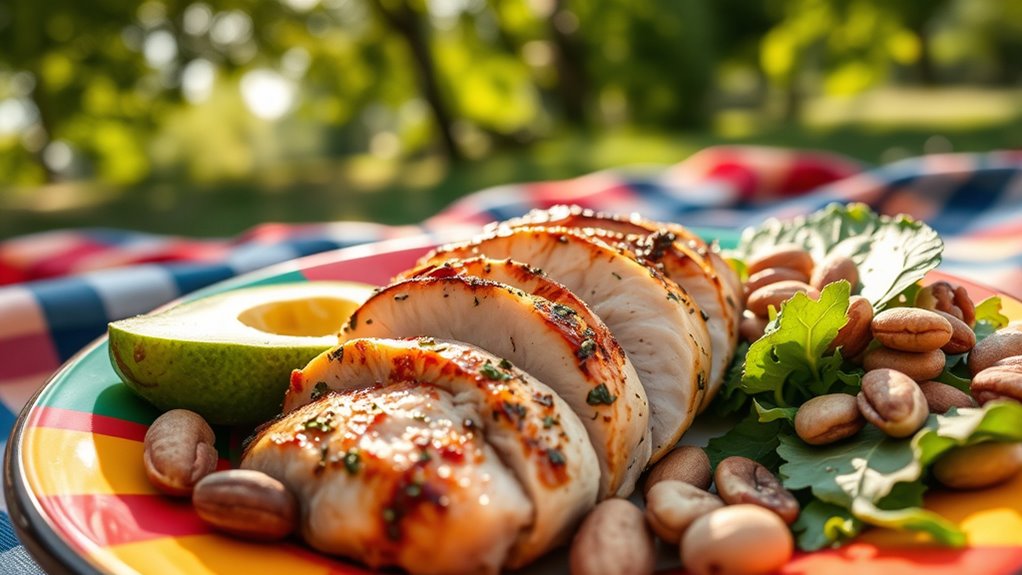
After fueling your body with carbohydrates to sustain energy during rides, focusing on proteins becomes essential for recovery and muscle repair. Proper protein timing helps maximize muscle rebuilding, especially after intense efforts. Consuming a protein-rich snack or meal within 30 to 60 minutes post-ride can reduce muscle soreness and speed up recovery. Additionally, ensuring the safety and trustworthiness of your nutritional information is vital, as AI security developments are increasingly influencing health and fitness advice. Proteins supply the amino acids needed to repair damaged muscle fibers and support adaptation. Skimping on protein may lead to increased soreness and longer recovery times, hindering your next ride. Aim for high-quality sources like lean meats, dairy, or plant-based options to ensure you’re getting essential amino acids. Incorporating evidence-based nutrition strategies can further optimize your recovery process. For example, optimizing performance upgrades like proper hydration and rest can significantly enhance your overall recovery and readiness. It is also beneficial to consider nutritional timing to align with your training schedule, maximizing the benefits of your dietary choices. Recognizing the importance of soulmate angel numbers can also inspire a positive mindset, encouraging patience and trust in your personal growth journey.
Healthy Fats and Their Importance for Endurance
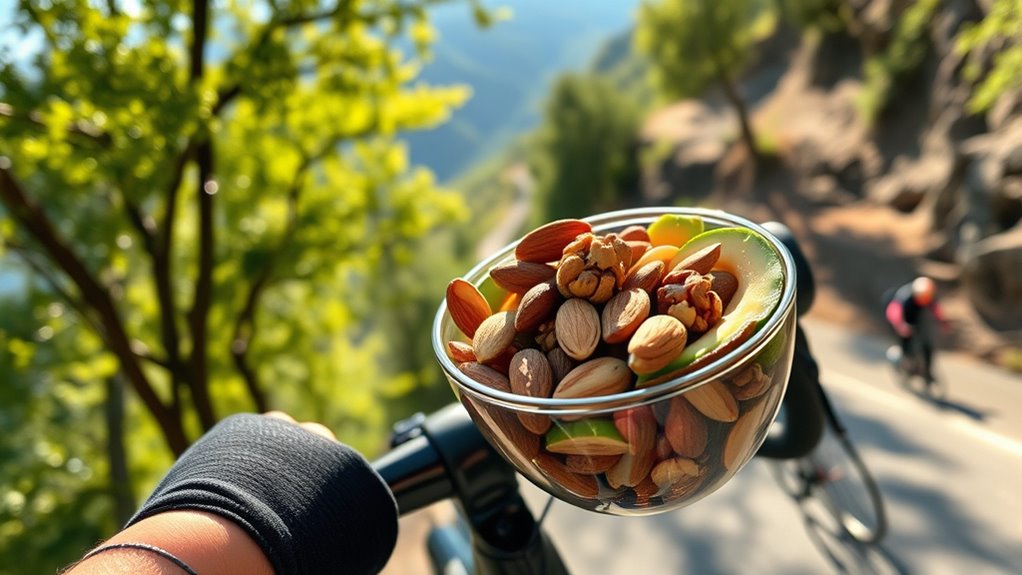
Healthy fats play a essential role in supporting your endurance during long rides, providing a dense source of sustained energy. They help you maintain stamina and recover faster. Incorporate plant-based fats like avocados, nuts, and seeds, which are rich in omega-3 sources that reduce inflammation and boost cardiovascular health. Prioritizing these fats ensures your body has a steady energy supply and promotes overall well-being. To optimize intake, consider the following:
| Food Item | Type of Healthy Fat | Key Benefit |
|---|---|---|
| Chia Seeds | Omega-3 sources | Anti-inflammatory, brain health |
| Walnuts | Plant-based fats | Heart health, energy boost |
| Flaxseeds | Omega-3 sources | Reduced inflammation |
| Almonds | Plant-based fats | Sustained energy |
| Avocado | Healthy monounsaturated fats | Recovery, joint health |
Incorporate these options into your diet to enhance endurance and performance.
Hydration Strategies Before, During, and After Rides
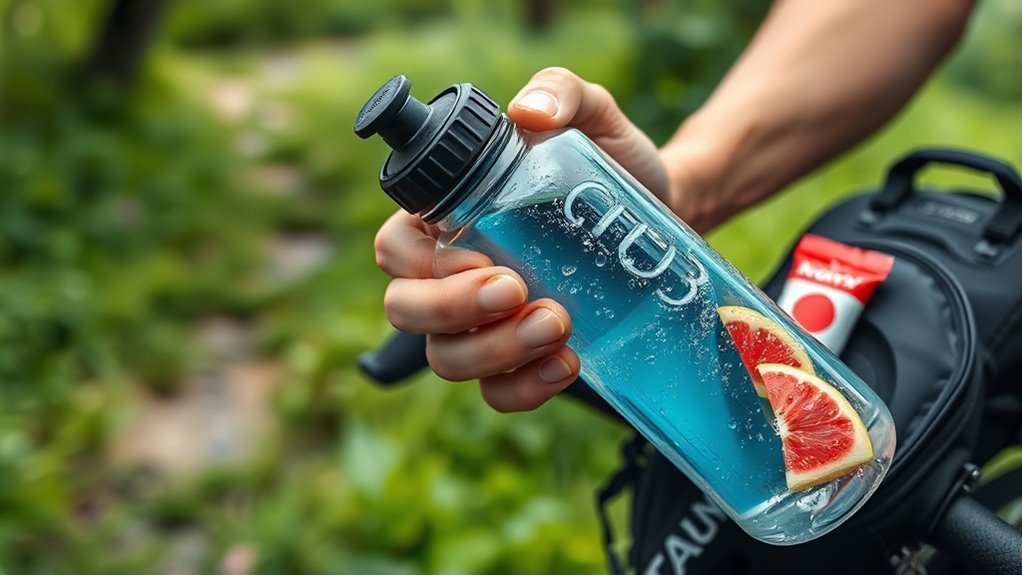
Proper hydration is essential to maintain your performance and prevent fatigue during cycling. Before your ride, drink fluids that help establish your electrolyte balance, such as water mixed with electrolyte tablets or sports drinks. This sets the hydration timing for sustained energy. Additionally, understanding hydration strategies can help you optimize fluid intake for different ride durations and conditions. Consuming appropriate fluids before riding can also enhance endurance and reduce the risk of dehydration. Staying mindful of fluid intake timing throughout your ride ensures consistent hydration and better performance. During your ride, sip fluids regularly to replace lost electrolytes and fluids, especially on hot days or long rides. Focus on electrolyte-rich drinks to avoid imbalances that cause cramping or dizziness. Maintaining emotional support during your rides can also boost motivation and mental resilience, especially during challenging segments. Incorporating proper nutrition alongside hydration can further improve your energy levels and overall cycling experience. After your ride, rehydrate with fluids containing electrolytes to restore your body’s balance and support recovery. Consistent hydration timing ensures you stay fueled and alert throughout your ride, reducing the risk of dehydration and optimizing your cycling performance.
Timing Your Nutrition for Peak Performance
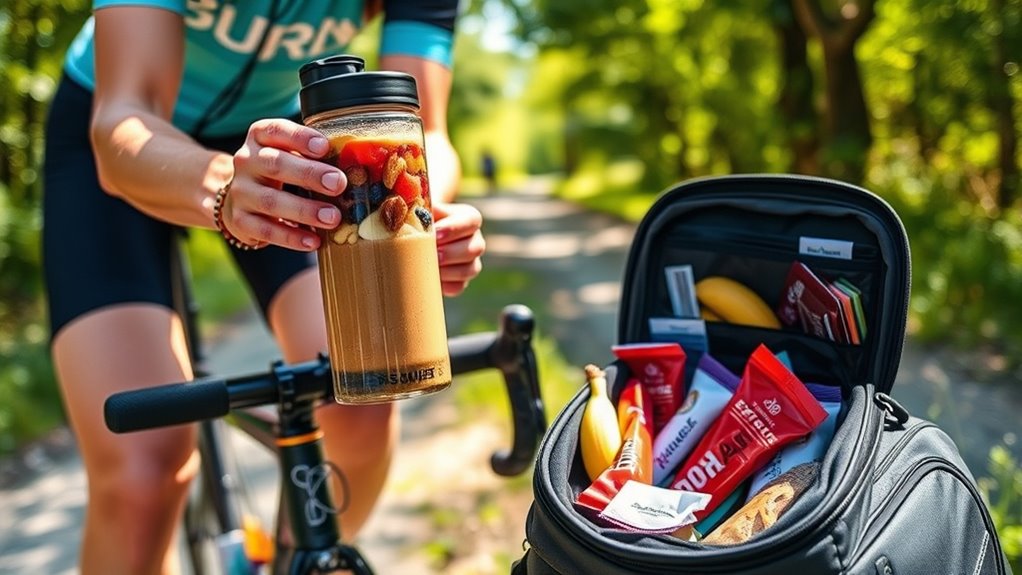
Getting your nutrition timed right can make a big difference in your cycling performance. Eating the right foods before your ride fuels you, while refueling afterward helps with recovery. Incorporating nutrient-rich ingredients into your meals can further enhance your metabolism and overall energy levels. Additionally, understanding brewing methods can help you prepare beverages that boost your stamina during rides.
Pre-Ride Nutrition
Ever wonder when to eat before a ride to maximize your energy? Proper meal timing and hydration level are key. Aim to eat a balanced meal 2-3 hours before riding, focusing on carbs and moderate protein. If you’re short on time, a small snack 30-60 minutes prior works too. Hydration is equally important; drink water regularly leading up to your ride. To help plan, here’s a quick guide:
| Time Before Ride | Suggested Nutrition |
|---|---|
| 2-3 hours | Carbohydrate-rich meal, some protein |
| 30-60 minutes | Light snack, fruit, or energy bar |
| Just Before | Hydrate with water, avoid heavy foods |
Balancing meal timing and hydration ensures you start your ride with ideal energy and focus. Proper pre-ride nutrition can also enhance your performance and endurance during the ride, especially when combined with adequate hydration. Incorporating proper storage techniques for your snacks and drinks can help maintain their freshness and nutritional value.
Post-Ride Recovery Fuel
After a tough ride, refueling promptly helps your body recover and prepares you for future rides. Proper meal timing strategies support gastrointestinal health and maximize nutrient absorption. Recognizing the importance of trust in relationships can also influence your motivation to maintain consistent fueling habits for optimal performance. Additionally, understanding how nutrient timing affects recovery can help you optimize your post-ride nutrition plan. To optimize recovery, consider these key points:
- Consume a balanced carbohydrate and protein meal within 30-60 minutes post-ride to replenish glycogen stores and repair muscles. Incorporating timely nutrition can further enhance recovery efficiency. Paying attention to meal composition ensures you’re getting the right nutrients for optimal healing.
- Prioritize easily digestible foods to minimize gastrointestinal discomfort.
- Hydrate thoroughly to restore fluid balance and support digestion.
- Plan your meals around your ride to avoid overeating or underfueling, which can impair recovery or cause gastrointestinal issues.
Incorporating appropriate post-ride nutrition can also enhance your immune function and overall well-being, making it easier to stay consistent with your cycling routine. Timing your nutrition correctly ensures your body recovers efficiently, maintains gastrointestinal health, and prepares you for your next ride.
Snacks and Energy Boosters for Long Rides
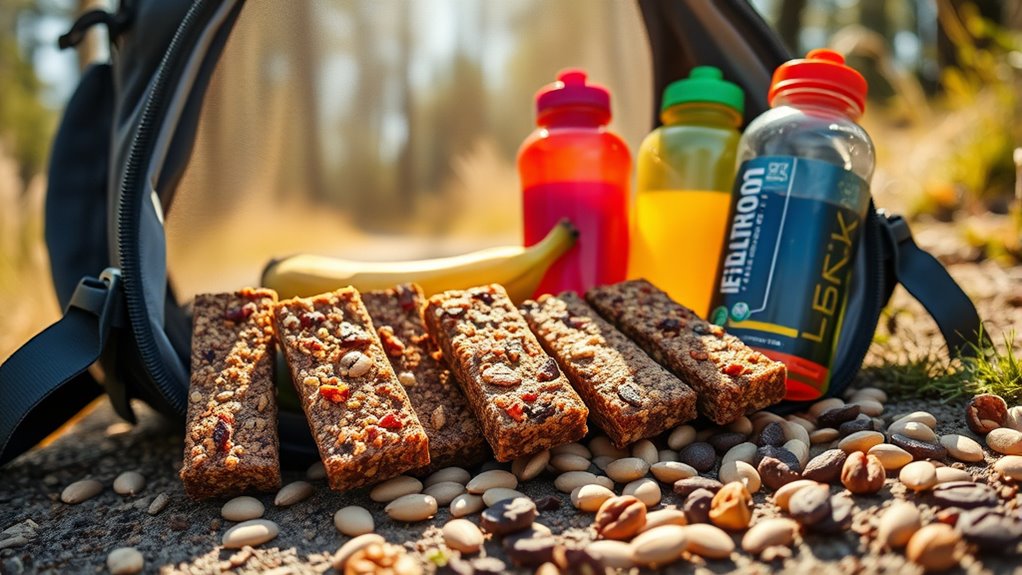
When you’re on a long ride, quick energy sources can keep you moving without missing a beat. Portable snacks like energy bars, dried fruits, or gels are easy to carry and boost your stamina when needed. Choosing the right options guarantees you stay fueled and focused throughout your journey. Incorporating energy-efficient snacks can further optimize your nutrition and maintain consistent performance. Additionally, selecting performance-oriented options tailored for endurance can provide sustained energy release to support your ride. Understanding market dynamics and consumer preferences can help you choose the most effective nutrition strategies for your cycling goals, especially when considering alimony laws and other legal factors that may impact your planning.
Quick Energy Sources
During long rides, having quick energy sources on hand can make a significant difference in maintaining your pace and stamina. Energy gels are compact and deliver concentrated carbs, perfect for an immediate boost. Fruit snacks are portable, natural options that replenish glycogen without weighing you down.
To maximize your performance, consider these options:
- Energy gels for rapid absorption during intense phases
- Fruit snacks like dried mango or raisins for sustained energy
- Chewy energy bars with simple carbs for quick recovery
- Electrolyte chews to maintain hydration and prevent cramping
These quick sources keep your energy levels steady and prevent fatigue. Keep them accessible in your jersey pockets, ensuring you can grab them without breaking rhythm. Combining these options with your regular nutrition plan will help you ride longer and stronger.
Portable Snack Options
Looking for portable snack options that can keep your energy steady on long rides? Energy gels are a convenient choice—they provide quick carbs without extra bulk. Trail mix is another excellent option, offering a mix of nuts, dried fruits, and seeds for sustained energy and healthy fats. To help you decide, consider this comparison:
| Snack Type | Benefits |
|---|---|
| Energy Gels | Fast-absorbing carbs, easy to carry |
| Trail Mix | Long-lasting energy, nutrient-dense |
Pack these snacks in small containers or pouches, ensuring they’re accessible during your ride. Combining energy gels for quick boosts and trail mix for lasting power can optimize your performance and keep fatigue at bay.
Post-Ride Nutrition: Replenishing and Repairing
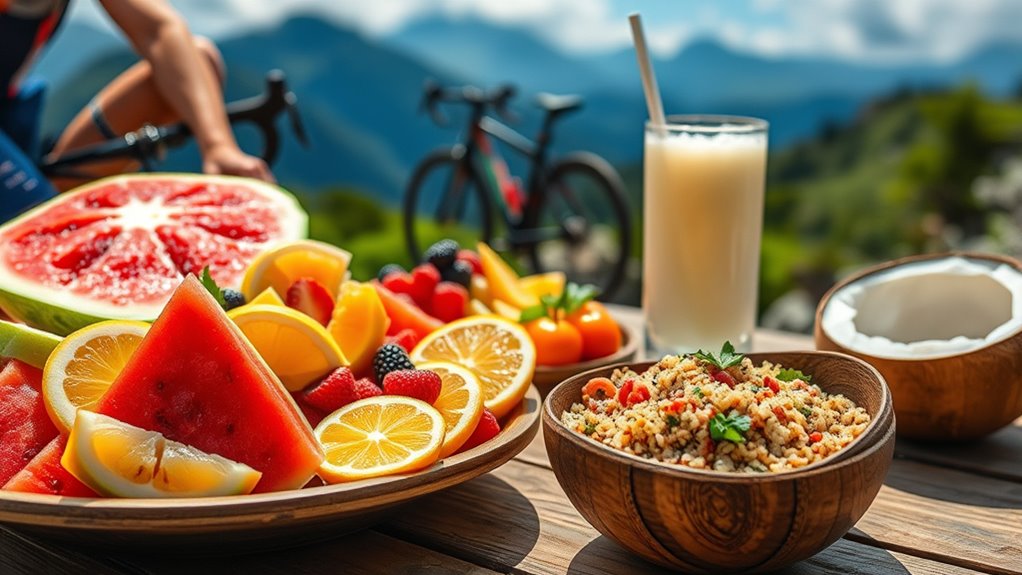
After completing your ride, refueling promptly is essential to kickstart the recovery process. Proper post-ride nutrition helps repair muscles and replenishes glycogen stores.
Hydrate with water or an electrolyte drink, especially if you sweated heavily.
Focus on balanced meals that include carbs and protein to optimize recovery.
Remember, your cycling gear and bike maintenance are crucial; well-maintained gear reduces injury risk, enabling consistent training.
To enhance recovery, consider these key points:
- Consume a carbohydrate-rich snack or meal within 30 minutes.
- Incorporate protein to support muscle repair.
- Rehydrate thoroughly to replace lost fluids.
- Plan your next ride by evaluating your nutrition and gear needs.
Supplements and When to Consider Them

Supplements can be beneficial for cyclists when used strategically to address specific nutritional gaps or performance goals. If you struggle to meet protein needs, adding protein smoothies can boost recovery and muscle repair. Vitamin supplements may also help fill micronutrient gaps, especially on busy training days. Contemplate supplements if your diet lacks variety or if you experience fatigue, cramping, or decreased stamina. Use them thoughtfully, not as a replacement for whole foods. Here’s a quick guide:
| Supplement Type | When to Consider |
|---|---|
| Protein smoothies | Post-ride recovery or when protein intake is low |
| Vitamin supplements | During busy schedules or nutrient deficiencies |
| Electrolytes | Long endurance rides or excessive sweating |
| Creatine | Strength training or power-focused cycling |
| Omega-3s | Reducing inflammation and joint health |
Creating a Personalized Nutrition Plan
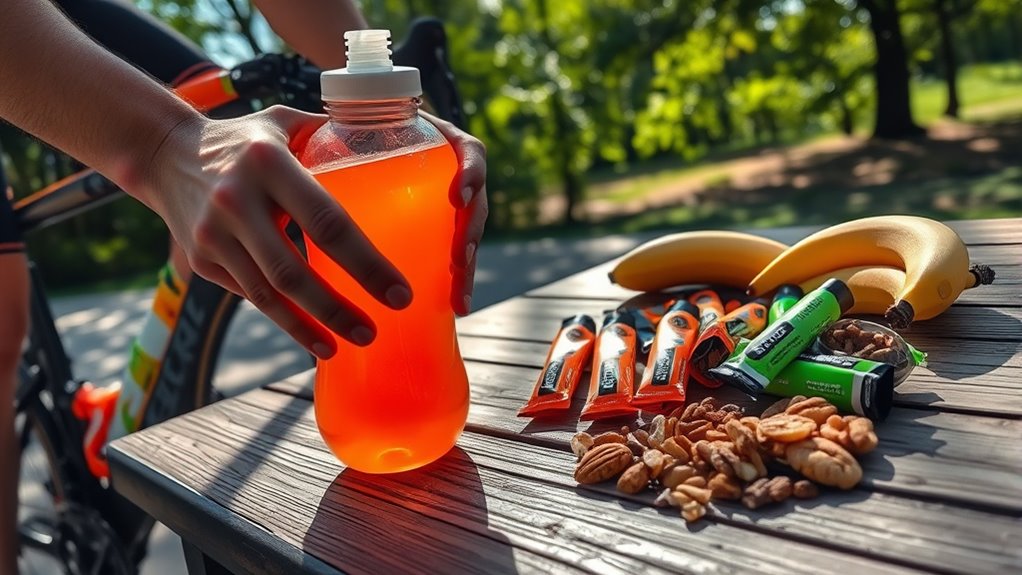
Creating a personalized nutrition plan starts with understanding your unique cycling goals, daily schedule, and dietary preferences. To optimize your performance, consider how meal timing influences energy levels and calcium absorption.
A well-timed meal before rides boosts endurance, while post-ride nutrition aids recovery. Focus on these key factors:
- Align your carbohydrate intake with your training intensity and timing.
- Incorporate calcium-rich foods to support bone health and optimize calcium absorption.
- Schedule meals strategically around rides to maintain energy and prevent fatigue.
- Adjust portion sizes based on your body’s response and daily activity level.
Common Nutrition Mistakes and How to Avoid Them
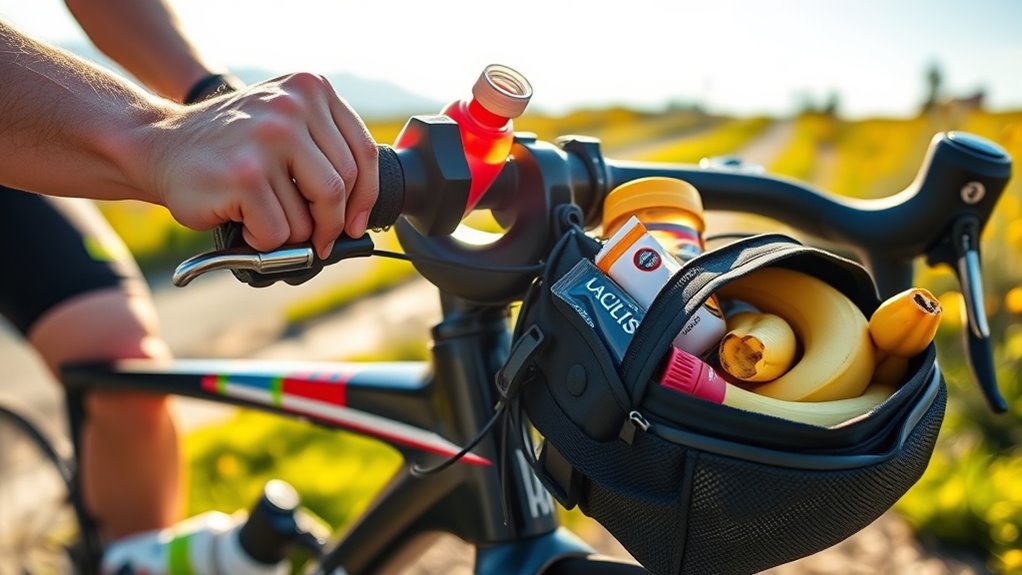
Many cyclists make common nutrition mistakes that can hinder performance and recovery. One key error is poor meal timing, such as skipping pre-ride meals or eating too late afterward, which can deplete energy and delay recovery. To avoid this, plan your meals around your rides, ensuring you fuel up properly beforehand and replenish afterward.
Another mistake involves neglecting hydration techniques; relying solely on water without electrolytes can lead to dehydration and cramps during long rides. Stay consistent with hydration, sipping fluids regularly and including electrolytes when needed.
Additionally, many underestimate the importance of balancing carbs, proteins, and fats in their diet. Being mindful of meal timing and hydration techniques helps optimize your energy levels, boost endurance, and support quicker recovery.
Frequently Asked Questions
How Does Altitude Affect Cycling Nutrition Needs?
Altitude effects can substantially impact your cycling nutrition needs. As you ride higher, your body uses more energy and loses fluids faster, so you need nutritional adjustments like increased carbohydrate intake and proper hydration.
You might also require more electrolytes to prevent imbalances. Be mindful of how altitude affects your performance and recovery, and adjust your fueling strategy accordingly to maintain your stamina and avoid altitude sickness.
What Are the Best Vegan Protein Sources for Cyclists?
You want to know the best vegan protein sources for cyclists. Focus on plant-based proteins like lentils, chickpeas, quinoa, tofu, and tempeh, which provide essential vegan amino acids.
Incorporate a variety of these foods in your diet to guarantee you’re getting complete protein profiles. By doing so, you support muscle repair and energy, helping you perform at your best during rides without relying on animal products.
How Can I Prevent Gastrointestinal Issues During Rides?
To prevent gastrointestinal issues during rides, focus on proper hydration strategies and digestive comfort. Drink fluids regularly, but avoid overhydration, which can cause discomfort.
Stick to easily digestible foods and avoid high-fat or high-fiber meals close to riding times. Listen to your body, and if you notice any issues, adjust your intake accordingly.
Proper hydration and gentle, familiar foods help keep your stomach settled and your performance steady.
Are There Specific Foods to Avoid Before Cycling?
Think of your stomach as a delicate balance beam—you don’t want it to wobble during your ride. Avoid greasy, high-fat foods, spicy dishes, and heavy proteins before cycling.
Instead, opt for light pre-ride snacks like bananas or oatmeal. Stay consistent with hydration strategies, avoiding excessive caffeine or sugary drinks that can cause discomfort.
These choices help you stay smooth and steady on every mile.
How Do Seasonal Changes Impact My Nutritional Requirements?
Seasonal changes can notably impact your nutritional needs. As seasons shift, you might need more hydration strategies during hot summers and richer, warmer foods in winter.
Incorporate seasonal produce to boost your intake of vitamins and minerals, helping your body adapt. Pay attention to how your body responds to weather changes, and adjust your diet accordingly to stay energized and hydrated for your rides.
Conclusion
Think of your nutrition plan as the engine that powers your ride. When you fuel it right with carbs, proteins, and healthy fats, you’ll cruise smoothly toward your goals. Stay hydrated and timing your meals guarantees you’re always ready to hit top speed. Avoid common pitfalls, and personalize your plan like tuning a bike for perfect performance. With the right fuel, every ride becomes a journey of progress, not just endurance.




